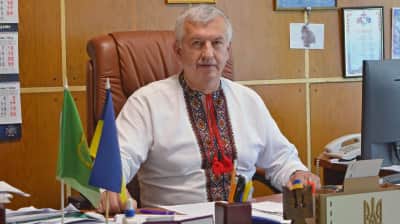How Russia is threatening the world with a nuclear catastrophe
For the first time in world history, a large-scale war is being waged in a country with more than a dozen nuclear reactors and thousands of tons of highly radioactive spent nuclear fuel.
Ukraine has 15 nuclear power units, including six at the 6,000 MW Zaporizhzhia NPP, Europe's largest, which also has a spent nuclear fuel repository.
On March 4, the Russian army captured the territory of the Zaporizhzhia nuclear power plant. The occupiers are holding the administrative buildings and the approach roads to the station.
The technical personnel of the power plant is at work and following the relevant protocols to prevent an accident.
As you already know, the occupation forces captured the Chornobyl NPP, and now Zaporizhzhia NPP. These are acts of nuclear terrorism.
It is evidenced by the fact that the Russian military is using the Chornobyl Exclusion Zone to deploy their weapons so that Ukraine couldn’t strike back. It is likely that such a scenario will be repeated at the Zaporizhzhia NPP.
We are very worried by active hostilities in Voznesensk, near the Yuzhnoukrainsk nuclear power plant.
The very presence of weapons on the territory of the power plants is already a great risk for the radioactive environment.
It is clear that the enemy wants to capture all major energy assets and to unbalance the power system, which now, despite active hostilities and significant damage, is fully functioning and providing Ukrainians with electricity.
Ukraine has already turned to the International Atomic Energy Agency (IAEA) to immediately request NATO to impose a no-fly zone over Ukraine’s nuclear facilities (the so-called A2/AD zone) and intensify efforts on preventing the acts of nuclear terrorism by Russia.
On March 4, after the capture of the Zaporizhzhya NPP, we heard the statement of the IAEA Director General. Regretfully, we have not heard any real proposals that could eliminate the threat of the Russian terrorist aggression on Ukraine's territory.
I would suggest that the IAEA leadership personally visit Ukrainian nuclear power plants, take a good look at Ukraine's destroyed cities, and assess the real extent of the threat while being there on the ground, or, at the very least, realise that there is an actual war going on, not a special "military operation of the Russian Federation’, as the IAEA Director General called it.
I hope that the IAEA understands that the nuclear power plant is threatened not only by the shelling and the possibility of reactor’s power system being disconnected and/or destroyed, but also by any interference in the normal operation of the nuclear power plant.
In general, nuclear power plants can be a target for the occupation forces to achieve the following:
- broad release of radioactive materials;
- disrupting power supply;
- creating an additional base for launching Russian missiles, knowing that the Ukrainian military will not retaliate;
- using the captured nuclear power plants as a bargaining chip during the so-called peace talks;
- their destruction upon retreat to cause significant damage and additional chaos.
1. None of Ukraine's nuclear power plants (like any other nuclear power plant in the world) is designed to be at the epicentre of hostilities, and radioactive releases from missiles hitting an active nuclear power plant could well exceed emissions from both Chernobyl and Fukushima.
In the worst-case scenario, the reactor and the cooling system may be destroyed. Under such a scenario, radioactive releases could render much of the European continent uninhabitable for many decades into the future and across hundreds and hundreds of kilometres.
A potential nuclear accident at the Zaporizhzhya NPP will be 6-10 times stronger in consequences compared to Chernobyl. This is a threat not only to Ukraine, Russia and Belarus, but to European countries as well.
2. Loss of power outside the site could be a major concern.
NPPs require an uninterrupted supply of electricity for cooling even when switched off. When the electricity network fails and the station is disconnected, spare diesel generators and batteries must be switched on, but the reliability of their operation for a sustained period of time cannot be guaranteed.
Hostilities could damage power plants or power lines that serve the reactor, and prevent diesel fuel from entering the station to replenish backup generators.
3. NPPs need a sophisticated support system to ensure their smooth operation, including the constant presence of qualified personnel, electricity, access to cooling water, spare parts and equipment. War can affect all of the above.
That is why the EU and the world need to mount a swift and powerful response to stop the war started by Russia and to make sure that military activity around the nuclear power plant does not lead to a new planetary catastrophe and that the existing nuclear power units are adequately protected.
We call upon NATO, Europe and the United States to close the skies and impose a safe no-fly zone over Ukraine, which will not only save the lives of our citizens, but also significantly reduce the risk of enemy missiles hitting Ukrainian nuclear power plants.
Importantly, even at a time of war, Energoatom and The Ministry of Energy of Ukraine are working to ensure that nuclear power plants are operating in safe conditions and that Ukrainians have a stable supply of electricity.
I call upon the conscious community in the whole world, the media – to fan the flames, because Putin’s favourite pastime playing terrorist this time could cost the European continent its very existence.





